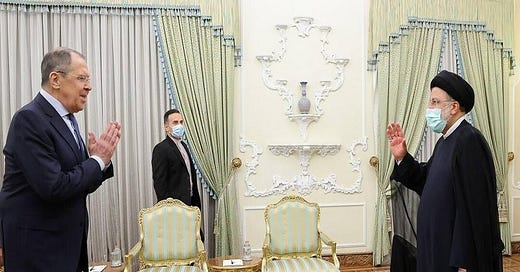Iran Is Russia’s Gateway To India
The takeaway is that Russian-Iranian relations are one of the foundations for multipolarity in the Eastern Hemisphere, without which Russian-Indian relations could never even consider approaching anything close to their full game-changing potential.
Russian Foreign Minister Lavrov’s trip to Iran has attracted enormous international attention given the Islamic Republic’s rising role in his Great Power’s grand strategy. It also follows Iran becoming increasingly active on the diplomatic scene after dispatching its Foreign Minister to India and hosting several Central Asian leaders. The reason behind all of this is that Iran is becoming the core of Eurasian connectivity projects, which in Russia’s case, turns it into the gateway to India.
The fate of the North-South Transport Corridor (NSTC) was uncertain for the past few years but has recently received a second wind as a result of dramatic events earlier this year. The US-led Western sanctions that were imposed in response to Russia’s ongoing special military operation in Ukraine practically cut Moscow off from most international logistics corridors, with the NSTC nowadays being the only one that it really still has access to.
In an instant, Iran’s importance to Russian grand strategy unprecedentedly skyrocketed as the Kremlin realized that the most viable route to its special and privileged Indian partner runs through the Islamic Republic. With India functioning as Russia’s irreplaceable valve from Western pressure that in turn preemptively averted its potentially disproportionate dependence on China and thus secured that Great Power’s strategic autonomy, it’s more urgent than ever for those two to cooperate more closely.
This explains why they’re teaming up with Iran to create a third pole of influence in the present bi-multipolar intermediary phase of the global systemic transition to multipolarity, which is the Eurasian half of India’s dual-tripolarity grand strategy that also involves ASEAN in the Indo-Pacific. That second-mentioned dimension isn’t that relevant to Russia though since Moscow scarcely wields any influence in Southeast Asia, which is Iran is its top priority in this respect.
Observers should therefore pay attention to this trend since it represents several layers of multipolar opportunities. First, Russian-Iranian relations are significant in and of themselves, but second, they also function as the gateway to India. Third, Russian-Indian relations are shaping the emerging Multipolar World Order, while those two team up with Iran in the fourth observation to create a third pole of influence. And finally, these trends are all strengthening Eurasian integration.
The takeaway is that Russian-Iranian relations are therefore one of the foundations for multipolarity in the Eastern Hemisphere, without which Russian-Indian relations could never even consider approaching anything close to their full game-changing potential. The Islamic Republic is keenly aware of this and is thus actively participating in this trilateral multipolar process, which it plans to leverage to turn itself to a Great Power to be reckoned with across the coming decade.




